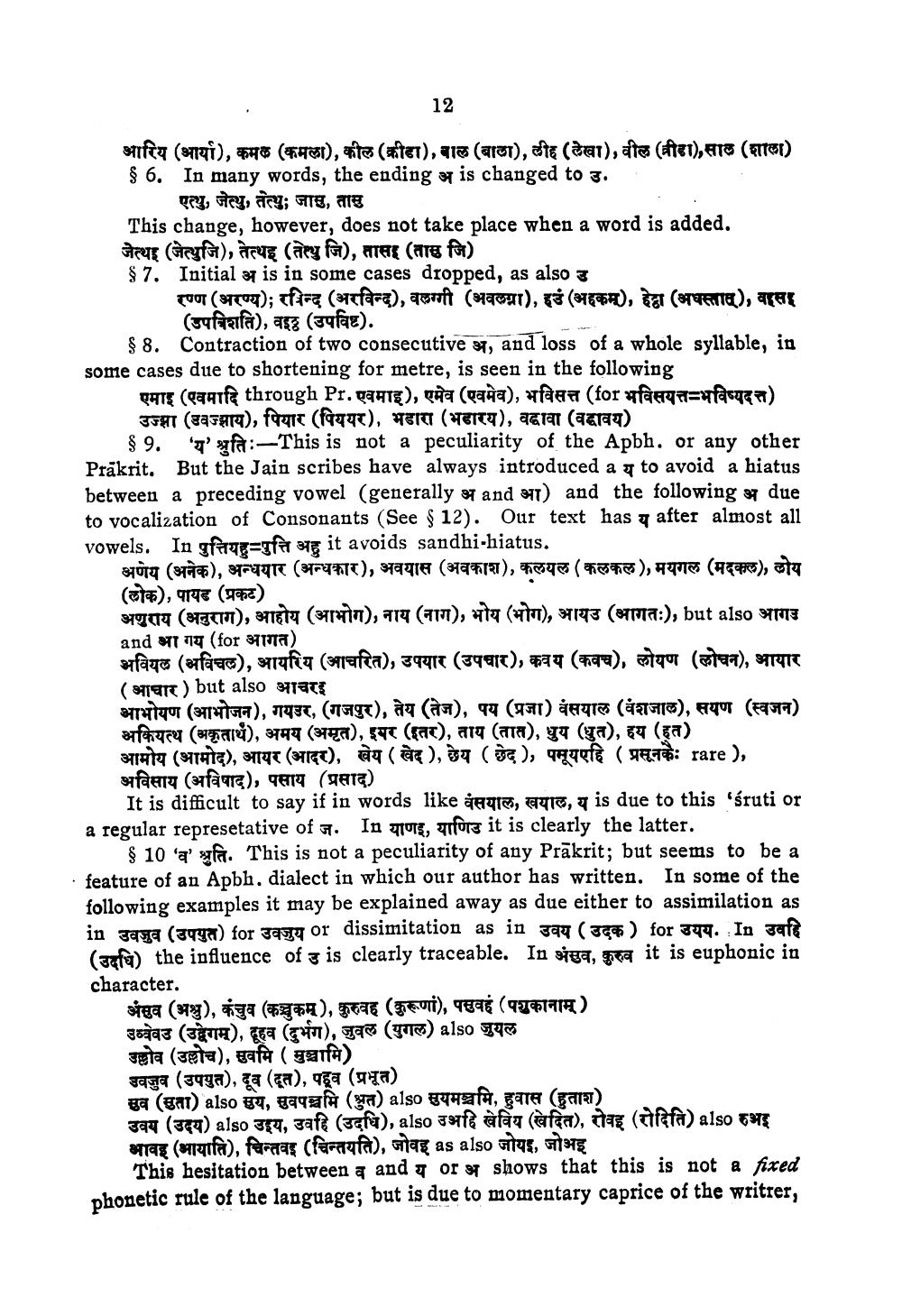________________
12
आरिय (आर्या), कमळ (कमला), कील (क्रीडा), बाल (बाळा), लीह (लेखा), वील (क्रीडा), साल (शाला) 6. In many words, the ending अ is changed to उ.
एत्थु, जेत्थु, तेत्थु; जासु, तासु
This change, however, does not take place when a word is added. जेत्थर (जेथुजि), तेत्थइ (तेत्यु जि), तासह (ता जि)
7. Initial अ is in some cases dropped, as also उ
रण (अरण्य); रविन्द ( अरविन्द), वलग्गी (अवलग्ना), हउं (अहकम), हेट्ठा (अधस्ताद), वहस (उपविशति), वठ्ठ (उपविष्ट).
88. Contraction of two consecutive अ, and loss of a whole syllable, in some cases due to shortening for metre, is seen in the following
ears (वमादि through Pr. एवमाइ ), एमेव (एवमेव ), भविसत्त (for भविसयत्त भविष्यदत्त ) उज्झा ( उवज्झाय), पियार (पिययर), भंडारा ( भडारय), वढावा (वद्यावय)
$9. 'य' श्रुतिः – This is not a peculiarity of the Apbh. or any other Prakrit. But the Jain scribes have always introduced a to avoid a hiatus between a preceding vowel (generally and T) and the following due to vocalization of Consonants (See § 12). Our text has after almost all vowels. In पुत्तियहु = पुत्ति अहु it avoids sandhi-hiatus.
अणेय (अनेक ), अन्धयार (अन्धकार), अवयास (अवकाश), कलयल ( कलकल), मयगल ( मदकल), लोय (लोक), पायड (प्रकट)
अणुराय (अनुराग), आहोय (आभोग), नाय (नाग), भोय (भोग), आयउ ( आगतः ), but also आगड and आ गय (for आगत)
अवियल (अविचल ), आयरिय (आचरित), उपयार (उपचार), कवय (कवच ), लोयण (लोचन), आयार ( आचार ) but also आचरइ
आभोयण (आभोजन), गयउर, (गजपुर), तेय (तेज), पय (प्रजा) वंसयाल (वंशजाल), सयण (स्वजन ) अकत्थ (अकृतार्थ), अमय (अमृत), इमर (इतर), ताय (तास), धुय (धुत), हय ( हूत) आमोय (आमोद), आयर (आदर), खेय ( खेद ), छेय (छेद), पसूयएहि ( प्रसूनकै: rare ), अविसाय (अविषाद), पसाय (प्रसाद)
It is difficult to say if in words like वंसयाल, खयाल, य is due to this 'śruti or a regular represetative of ज. In याणइ, याणिउ it is clearly the latter.
$ 10 'व' श्रुति. This is not a peculiarity of any Prākrit; but seems to be a feature of an Apbh. dialect in which our author has written. In some of the following examples it may be explained away as due either to assimilation as in वजुव (उपयुत) for उवजय or dissimitation as in उवय (उदक ) for उयय. In उवहि (उदधि) the influence of उ is clearly traceable. In अंडव, कुरुव it is euphonic in character.
अव (अ), कंचुव (कञ्चुकम् ), कुरुवह (कुरूणां), पसुवहं (पशुकानाम् ) उब्वे (उद्वेगम), दूहव (दुर्भग), जुवल (युगल) also जुयल उल्लोव (उल्लोच), सुवमि ( मुञ्चामि )
जुव (उपयुक्त), दूव (दूत), पहूव ( प्रभूत)
स्रुव (सुता) also सुय, सुवपञ्चमि (श्रुत also सुयमञ्चमि, हुवास (हुताश )
उवय (उदय) also उद्दय, उवहि (उदधि), also उअहि खेविय (खेदित), रोवइ (रोदिति ) also रुभइ
आवs (आयात), चिन्तवइ (चिन्तयति), जोवह as also जोयइ, जोभइ
This hesitation between a and or shows that this is not a fixed phonetic rule of the language; but is due to momentary caprice of the writrer,




